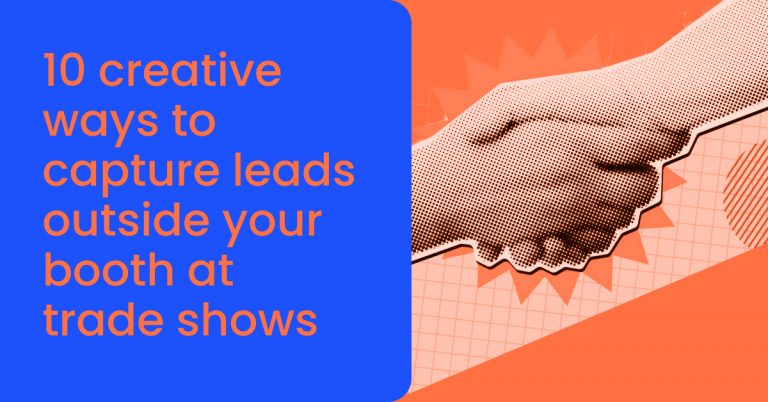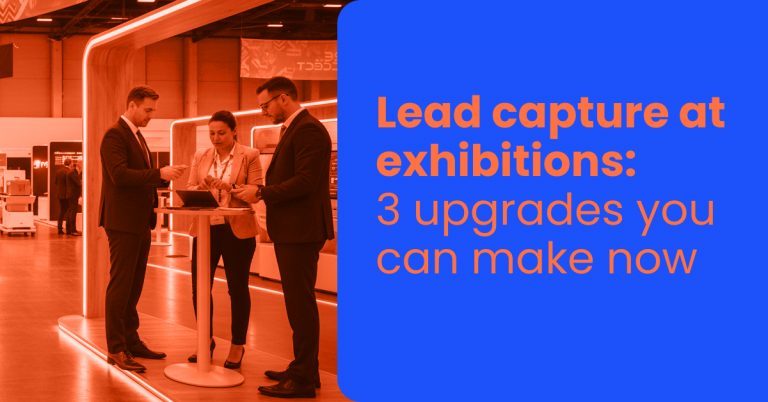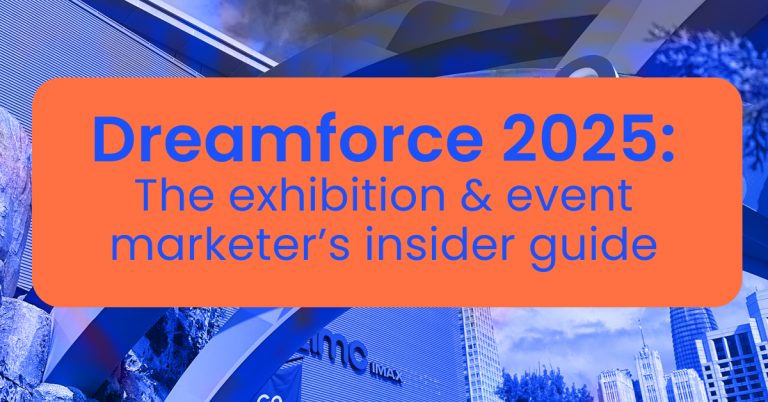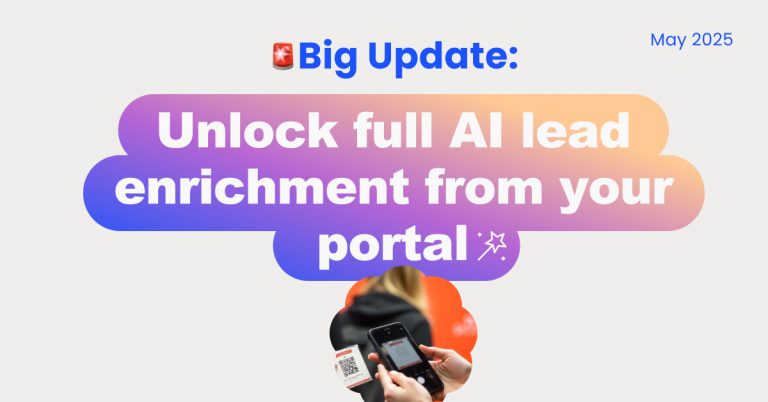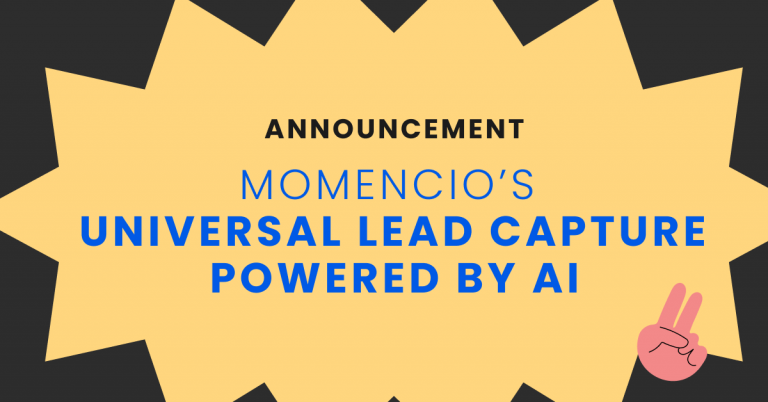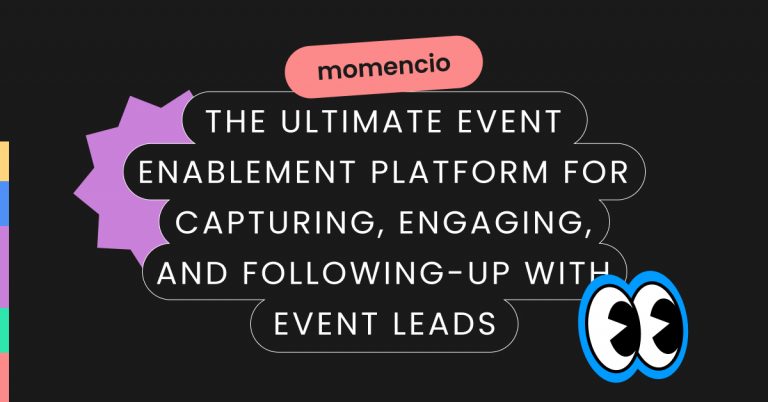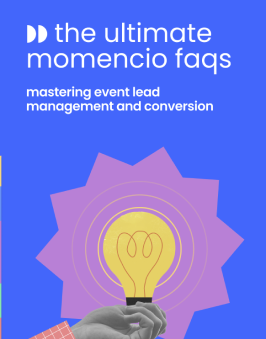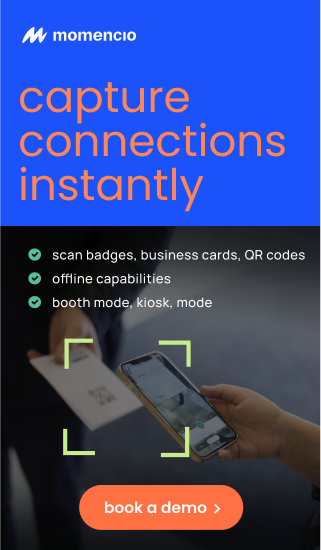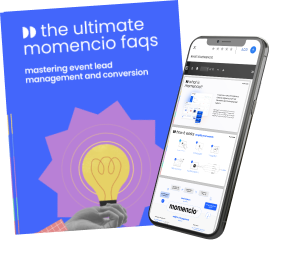B2B trade fairs are not just events—they are high-stakes arenas where businesses showcase their expertise, build trust, and ignite relationships that can fuel long-term growth. For many companies, trade fairs represent a significant investment, from the cost of booth space to marketing collateral and travel expenses. Yet, despite the immense potential, a staggering 79% of leads gathered at trade fairs are left unengaged, vanishing into the abyss of forgotten opportunities.
Why does this happen? The culprit often lies in outdated manual follow-up processes. When leads are scribbled on paper, misplaced in spreadsheets, or delayed due to disorganized workflows, they lose their momentum. The result? Missed connections, wasted budgets, and an unclear return on investment.
Automation is rewriting this story. With tools designed to capture, organize, and engage leads in real-time, businesses no longer have to struggle with inefficiencies. Imagine this: A visitor scans their badge at your booth, and within minutes, they receive a personalized email about your products tailored to their specific needs. Behind the scenes, their data syncs seamlessly with your CRM, alerting your sales team to prioritize a follow-up call. This isn’t just a dream scenario—it’s the reality of automated lead management.
Companies that integrate automation into their trade fair strategies report dramatic improvements. According to recent studies, businesses see a 35% increase in lead conversion rates and a 40% reduction in follow-up time after adopting automation. These numbers highlight what savvy marketers and sales teams already know: the speed and precision of automation are game-changers in the competitive world of B2B trade fairs.
In this article, we’ll dive deep into the 11 benefits of automating lead follow-ups after B2B trade fairs. From reducing manual errors to providing real-time insights and enhancing ROI tracking, you’ll discover why automation isn’t just a tool but an essential strategy for maximizing the value of your trade fair participation. Whether you are a VP of Marketing, a Sales Manager, or an Event Planner, this guide will help you unlock the full potential of your event investments.
So, buckle up. It’s time to turn your B2B trade fair efforts into a well-oiled machine that works harder, faster, and smarter than ever before. Let’s start with the first big win: improving lead capture and follow-up efficiency.
Continue reading to discover how to keep the momentum alive, long after the trade fair doors close.
11 benefits of automating B2B trade fair lead follow-up
1. Enhanced lead capture and follow-up efficiency
When it comes to B2B trade fairs, the clock starts ticking the moment an attendee visits your booth. Every second that passes without capturing their details and initiating engagement is a missed opportunity. This is where automation excels, enabling businesses to collect and respond to leads with unprecedented speed and precision. Let’s explore how automating these processes sets you up for success.
Instant data retrieval: a seamless experience
Traditional methods of capturing leads—business card exchanges or hastily written notes—are inefficient and prone to error. Automation tools like badge scanners or digital kiosks simplify this process, ensuring every interaction is logged accurately.
- Smart badge scanning: Modern platforms can extract key data such as name, company, and contact details directly from attendee badges. In seconds, this information is stored in your CRM or lead management tool.
- Business Card: For attendees without badges, momencio can scan and capture details from their business cards, allowing instant input of their details, eliminating transcription errors.
Example: At a bustling trade fair, your booth is packed with potential leads. Instead of fumbling with paperwork, a quick badge scan captures all the information you need. By the time the attendee moves on, your automation system has already queued up a personalized follow-up email.
Speeding up the follow-up game
Studies show that businesses responding to leads within the first hour are seven times more likely to convert them into customers. Automation tools empower your team to act at lightning speed by automating initial communications and task assignments.
- Instant email automation: Once a lead is captured, they receive a customized email that addresses their specific interests. Whether it’s a product brochure or a case study, the content is relevant and timely.
- Task automation for sales teams: Automated systems notify your sales team with detailed lead information, including engagement history, so they can prioritize follow-ups effectively.
Companies using automated tools report a 30% improvement in lead response times, giving them a significant edge over competitors who rely on manual methods.
Eliminating human error: a critical advantage
Manual data entry is not just tedious—it’s risky. A simple typo or misplaced file can lead to lost leads or ineffective follow-ups. Automation removes the human error factor by:
- Capturing data directly from verified sources like badge scanners and digital forms.
- Ensuring seamless syncing with CRMs, keeping lead data organized and accessible.
Pro tip: Invest in automation platforms that integrate directly with your CRM. This ensures your leads are always updated in real time, reducing the chances of double entries or missing details.
Centralized lead management: simplifying complexity
Trade fairs often generate hundreds, if not thousands, of leads. Managing this influx manually can feel overwhelming. Automation offers a centralized solution:
- Real-time lead tracking: Monitor which leads have been captured, their engagement history, and their position in the sales funnel—all from a single dashboard.
- Streamlined communication: Automation platforms enable cross-functional teams to collaborate seamlessly. Marketing can focus on nurturing leads, while sales prioritize high-value opportunities.
Real-world application: Imagine attending three trade fairs in a month, each yielding hundreds of leads. Instead of juggling spreadsheets and emails, your centralized system categorizes leads by priority, assigning tasks to the right team members.
Elevating your brand image
Efficiency isn’t just about internal processes—it impacts how attendees perceive your brand. When your team uses automation to respond promptly and professionally, it demonstrates competence and attention to detail.
- Enhanced attendee experience: Attendees are more likely to engage with businesses that provide timely, personalized follow-ups.
- Professionalism on display: Automated solutions showcase your commitment to leveraging technology, leaving a lasting impression on potential clients.
Automation transforms lead capture and follow-up into a streamlined, error-free process that positions your business for success. By ensuring no lead slips through the cracks, you maximize your trade fair ROI and set the stage for higher conversions.
2. Increased lead conversion rates
Capturing leads is only the beginning; converting those leads into customers is where the true value lies. Automating your B2B trade fair follow-ups can significantly enhance conversion rates by optimizing lead scoring, prioritization, and nurturing processes. Let’s break down how automation helps turn interest into tangible sales outcomes.
Real-time lead scoring and prioritization
Not all leads are created equal. Some prospects are ready to buy, while others may need further nurturing. Automation tools use advanced algorithms to score leads based on their engagement level, interests, and interactions during the trade fair.
- Data-driven prioritization: Systems analyze behaviors like booth visits, downloads, or interactions to rank leads by sales-readiness.
- Focus on high-value opportunities: Your sales team can concentrate their efforts on the most promising leads, boosting their productivity and effectiveness.
Example: If a prospect spends 10 minutes watching a product demo at your booth and downloads a whitepaper through your microsite, the system flags them as a high-priority lead. This insight ensures they receive immediate attention from your sales team.
Personalized nurturing campaigns
The days of generic follow-ups are over. Today’s buyers expect tailored communication that addresses their specific needs and pain points. Automation empowers you to craft personalized email sequences, microsites, and content offers that resonate with individual leads.
- AI-driven content recommendations: Automation tools analyze lead data to suggest content tailored to their industry or interests.
- Dynamic email campaigns: Automated follow-ups adjust based on lead behavior, ensuring every touchpoint adds value.
Personalization in follow-ups has been shown to increase response rates by 26%, giving you a clear edge over competitors relying on one-size-fits-all messaging.
Building trust through consistency
Consistency is key to building trust and keeping your brand top of mind. Automation ensures every lead receives timely and relevant follow-ups without any gaps.
- Timely outreach: Leads receive follow-ups immediately after their interaction, reinforcing your commitment to addressing their needs.
- Multiple touchpoints: With automated systems, you can schedule a series of follow-ups over days or weeks, ensuring consistent engagement without overwhelming the prospect.
Leveraging insights for targeted strategies
Automation tools collect valuable data on lead interactions, from email clicks to microsite visits. These insights allow your team to refine their approach and align their pitch with the lead’s evolving interests.
Pro tip: Use analytics dashboards to identify trends in lead behavior. If a majority of leads engage with a specific product page, consider tailoring your outreach to highlight that product’s benefits.
Enabling seamless handoffs to sales
Nothing frustrates a potential customer more than repeating their needs to multiple representatives. Automation bridges the gap between marketing and sales, ensuring seamless handoffs and better communication.
- Unified data access: Sales teams gain instant access to detailed lead profiles, including interaction history and preferences.
- Efficient follow-through: Armed with context, sales reps can personalize their outreach, fostering stronger connections with prospects.
Automating follow-ups isn’t just about efficiency; it’s about creating meaningful interactions that inspire confidence and drive conversions. Next, let’s explore how CRM integration plays a pivotal role in connecting your trade fair efforts to your broader sales strategy.
3. Seamless CRM integration
Automation becomes even more powerful when paired with a robust customer relationship management (CRM) system. Seamless CRM integration ensures that every piece of lead data captured at a B2B trade fair is accessible, organized, and actionable. This integration bridges the gap between marketing and sales, streamlining efforts and maximizing the impact of your trade fair participation.
Effortless data syncing
Manual data entry is not only time-consuming but prone to errors that can derail your follow-up strategy. Automation tools with CRM integration simplify this process by syncing lead information directly into your CRM system.
- Real-time updates: Leads captured at the event—whether through badge scanning, digital forms, or app interactions—are instantly uploaded to your CRM.
- Accurate records: Automated syncing eliminates duplication and ensures that all lead data is consistent and complete.
Example: At the end of a trade fair, your CRM is already populated with detailed profiles of every lead, including their contact information, engagement history, and scoring metrics. Your team can start follow-ups immediately without waiting for data processing.
Better alignment between marketing and sales
A well-integrated CRM ensures that marketing and sales teams work from the same playbook, reducing miscommunication and improving collaboration.
- Shared visibility: Both teams can access the same lead profiles, engagement history, and notes, ensuring continuity in outreach efforts.
- Actionable insights: Marketing can track which campaigns resonate with leads, while sales can focus on high-priority prospects with clear next steps.
Companies with strong marketing and sales alignment achieve 38% higher sales win rates, underscoring the value of seamless collaboration.
Enhanced lead management
With CRM integration, you can go beyond simple lead storage to actively manage the entire lifecycle of each contact.
- Lead segmentation: Group leads by criteria such as engagement level, industry, or product interest for targeted follow-ups.
- Pipeline tracking: Monitor where each lead is in the sales funnel and adjust your strategy accordingly.
Pro tip: Use CRM reports to identify bottlenecks in your lead conversion process. For example, if many leads stall at a specific stage, adjust your messaging or tactics to address potential concerns.
Driving data-informed decisions
The integration of automation tools and CRM systems provides powerful analytics that inform your strategy and improve results.
- Performance dashboards: Track metrics like response rates, email opens, and content engagement to refine your approach.
- ROI measurement: Calculate the effectiveness of your trade fair investment by linking leads to closed deals and revenue generated.
Improving customer experience
When leads feel understood and valued, they’re more likely to convert. CRM integration ensures a seamless experience by maintaining context throughout the sales journey.
- Contextual outreach: Sales reps have access to detailed lead histories, allowing them to tailor their communication.
- Consistent messaging: Automation ensures that every interaction reinforces your brand’s value proposition.
Seamless CRM integration is the backbone of a successful trade fair follow-up strategy. It ensures that no lead is lost, aligns teams for maximum efficiency, and delivers the insights needed to close more deals. Next, let’s explore how personalization takes your follow-ups to the next level, creating stronger connections with your leads.
4. Improved personalization in communication
Personalization is no longer a luxury in B2B marketing—it’s a necessity. Buyers expect tailored interactions that address their specific challenges and goals. Automation enables you to deliver personalized communication at scale, making every touchpoint feel relevant and meaningful.
Crafting tailored email campaigns
Gone are the days of generic follow-ups that fail to capture attention. Automation platforms allow you to design dynamic email campaigns that adapt to each lead’s behavior, preferences, and trade fair interactions.
- Customized content: Emails are populated with details such as the lead’s name, company, and topics of interest gathered during the event.
- Trigger-based sequences: Follow-ups are automatically sent based on actions like booth visits, downloads, or website activity.
Personalized emails generate a 122% higher return on investment, proving their effectiveness in building stronger connections.
Example: A lead who expressed interest in a specific product at your booth receives a follow-up email featuring a case study that highlights the product’s benefits for their industry.
Dynamic microsites for deeper engagement
Beyond emails, automation enables the creation of personalized microsites—dedicated web pages tailored to each lead’s interests.
- Curated content: Microsites can feature product demos, testimonials, and downloadable resources specific to the lead’s industry or pain points.
- Interactive experiences: Include quizzes, ROI calculators, or videos to keep leads engaged and encourage further exploration.
Pro tip: Use microsites as a platform for lead nurturing. Track visitor behavior to refine your follow-up strategy and offer additional resources that align with their interests.
Aligning communication with lead behavior
Automation tools provide real-time insights into how leads interact with your content, allowing you to adjust your approach dynamically.
- Behavior-based follow-ups: For example, if a lead clicks on a pricing page, the next email can offer a consultation with a sales rep.
- Targeted messaging: Leads who engage heavily with technical content might prefer detailed product specifications, while others might benefit from case studies or testimonials.
Building trust through relevance
Personalized communication demonstrates that you understand your leads’ unique challenges and are invested in helping them succeed.
- Showing empathy: Acknowledging specific pain points or goals creates a sense of trust and partnership.
- Delivering value: Providing resources or solutions tailored to their needs shows your commitment to solving their problems.
Example: A lead mentions during your booth interaction that their main concern is reducing costs. Your follow-up emails highlight how your solution saves money, complete with industry benchmarks to validate the claim.
Reducing unsubscribe rates
Irrelevant messages can drive leads away, but personalization keeps them engaged.
- Event marketers using personalized email strategies report a 26% decrease in unsubscribe rates, indicating stronger audience retention.
Tip: Segment your email lists based on trade fair interactions to ensure that every message resonates with the recipient.
Personalization transforms your communication from generic to impactful, creating meaningful connections that accelerate the buyer’s journey. Next, we’ll explore how automation delivers significant time and cost savings, making it a must-have for trade fair success.
5. Time and cost savings
For businesses participating in B2B trade fairs, the ability to save time and cut costs without sacrificing results is a game-changer. Automation achieves both by streamlining workflows, reducing manual effort, and optimizing resource allocation. Let’s dive into how automation helps you do more with less.
Reducing manual labor
One of the most immediate benefits of automation is the significant reduction in manual tasks. From lead data entry to follow-up email creation, automation handles repetitive tasks, freeing your team to focus on strategic activities.
- Data capture efficiency: Tools like badge scanners and digital forms instantly collect and organize lead information, eliminating hours of manual input.
- Automated follow-ups: Pre-built email templates and workflows handle initial communication, ensuring leads are engaged without requiring constant attention from your team.
Example: Instead of spending hours logging leads into a spreadsheet, your team can focus on personalizing their outreach or planning next steps.
Cutting operational costs
Time saved is money earned. Automation tools reduce the need for additional manpower, ensuring your resources are utilized efficiently.
- Scalable solutions: Automation systems can manage hundreds of leads simultaneously, removing the need to hire temporary staff for post-trade fair follow-ups.
- Reduced errors: By minimizing human input, automation avoids costly mistakes such as missed leads or incorrect contact details.
Businesses that invest in automation tools report up to a 30% reduction in administrative costs, making it an economical choice for long-term success.
Streamlining cross-team collaboration
Automation enhances collaboration between marketing and sales teams, saving time spent on back-and-forth communication.
- Centralized data access: Both teams can access real-time lead profiles, ensuring alignment on outreach priorities.
- Task automation: Assigning follow-ups and updating lead statuses are automated, keeping everyone on the same page.
Pro tip: Use workflow automation to assign high-priority leads directly to senior sales reps, ensuring faster responses and higher conversion rates.
Faster decision-making with real-time analytics
Time-sensitive decisions are critical in the fast-paced environment of post-trade fair follow-ups. Automation tools provide real-time insights that empower teams to act quickly and effectively.
- Engagement tracking: Monitor which leads are interacting with your content and prioritize them for immediate outreach.
- Dynamic adjustments: If a follow-up campaign underperforms, automation allows you to tweak messaging or offers in real-time.
Optimizing marketing spend
Automation ensures that every dollar spent on trade fair participation yields maximum returns by focusing efforts on high-potential leads.
- ROI tracking: Detailed analytics reveal the cost per lead and revenue generated, helping you justify event investments.
- Reduced lead decay: Faster follow-ups prevent leads from going cold, increasing the likelihood of conversion and maximizing the value of your trade fair presence.
Example: A business using automation to follow up with trade fair leads within 24 hours saw a 40% higher response rate compared to delayed manual outreach, translating into faster sales cycles and reduced costs.
Making automation work for you
Implementing automation doesn’t just save time—it creates opportunities for smarter allocation of resources. By letting the technology handle the heavy lifting, your team can focus on building relationships and driving growth.
Next, let’s examine how real-time data analytics takes your automation strategy to the next level, providing actionable insights for continuous improvement.
6. Real-time data analytics for decision-making
In the competitive landscape of B2B trade fairs, actionable insights are the key to outpacing your competitors. Automation tools equipped with real-time data analytics provide a window into lead behaviors, campaign performance, and event ROI. These insights empower you to make informed decisions that optimize follow-ups and enhance results.
Understanding lead behavior
Automation tools track how leads interact with your content and communication, offering valuable behavioral insights.
- Engagement metrics: Monitor email opens, link clicks, microsite visits, and downloads to gauge interest levels.
- Journey mapping: Analyze the path leads take through your content to identify patterns and tailor future outreach.
Example: If a lead visits your pricing page multiple times but doesn’t engage further, your sales team can proactively reach out with tailored offers or incentives.
Prioritizing high-potential leads
Real-time analytics help you focus resources on the leads most likely to convert.
- Lead scoring: Automated systems assign scores based on engagement metrics, ensuring sales teams prioritize high-value opportunities.
- Trigger alerts: Receive notifications when leads take significant actions, such as scheduling a demo or downloading a whitepaper.
Companies using real-time analytics see a 20% increase in sales productivity by focusing efforts on the most engaged prospects.
Optimizing campaigns on the fly
Real-time data allows you to adjust your follow-up strategies dynamically, ensuring maximum effectiveness.
- Adaptive messaging: If a particular email sequence underperforms, you can tweak subject lines or content to improve results.
- A/B testing: Test different approaches for follow-ups in real-time to identify what resonates best with your audience.
Pro tip: Use analytics dashboards to compare the performance of different campaigns across trade fairs. Identify which tactics drive the best results and replicate them in future events.
Tracking ROI with precision
Automation tools make it easy to measure the impact of your trade fair investments, helping you justify budgets and refine strategies.
- Conversion tracking: Link captured leads to closed deals to calculate the exact ROI of your participation.
- Channel attribution: Determine which touchpoints—emails, microsites, or in-person interactions—contribute most to conversions.
Example: By tracking the full journey of a lead from booth interaction to sale, you can present a clear picture of how trade fairs drive revenue growth.
Fostering continuous improvement
The insights gained from real-time data don’t just benefit current campaigns—they inform long-term strategies for better results.
- Event analysis: Evaluate which trade fairs deliver the highest ROI and align your participation with the most profitable opportunities.
- Team performance: Identify areas where marketing and sales teams excel or need support, ensuring consistent improvement over time.
Real-time data analytics transforms your trade fair follow-ups from guesswork into precision-driven strategies. With insights guiding every decision, you’ll not only improve lead conversion rates but also elevate your overall trade fair performance.
7. Improved attendee experience
In B2B trade fairs, the attendee’s experience is as critical as the business outcomes. Automation doesn’t just streamline your internal processes—it also creates smoother, more personalized interactions that leave a lasting impression on potential clients. A positive attendee experience fosters trust, strengthens relationships, and enhances your brand’s reputation.
Simplifying interactions at the booth
Automation tools can transform your trade fair booth into a hub of seamless engagement, ensuring every visitor feels valued.
- Quick badge scanning: Instead of lengthy forms or disorganized exchanges, attendees simply scan their badges for instant check-in.
- Instant access to content: With automation, you can immediately share personalized content—such as brochures or demo videos—via email or microsites.
Example: A prospect visits your booth and mentions interest in a specific product. Within minutes of scanning their badge, they receive a personalized email with relevant case studies, showcasing your responsiveness and attention to detail.
Personalizing follow-up communications
Tailored communication makes attendees feel that your business understands their needs, enhancing their post-event experience.
- Dynamic email content: Automation tools allow you to craft emails that reflect an attendee’s specific interests or interactions at the booth.
- Interactive microsites: Personalized web pages offer a curated experience, featuring content aligned with their expressed preferences.
Attendees who receive personalized follow-ups are 80% more likely to engage further, highlighting the importance of tailored communication.
Creating opportunities for re-engagement
Automation enhances the attendee experience by providing multiple touchpoints for continued engagement after the event.
- Gamification: Use fun, interactive tools like quizzes or contests to maintain interest and gather more insights.
- Feedback loops: Send automated surveys to attendees, allowing them to share their opinions while keeping your brand top of mind.
Pro tip: Gamify lead nurturing by offering incentives, such as discounts or exclusive content, to attendees who complete specific actions on your microsite.
Demonstrating professionalism
Attendees often evaluate potential partners based on how organized and responsive they are. Automation tools help you present a polished, tech-savvy image.
- Timely follow-ups: Leads receive immediate communication, signaling that your business values their time and interest.
- Consistent messaging: Automated workflows ensure every interaction aligns with your brand’s voice and values.
Reducing friction in the attendee journey
The smoother the process, the more positive the experience. Automation minimizes friction by making every step—from data capture to follow-up—efficient and error-free.
- Streamlined transitions: Attendees move seamlessly from initial interactions to deeper engagements, such as scheduling demos or accessing tailored content.
- Proactive communication: Automation tools can anticipate attendee needs based on their behavior, delivering resources before they even request them.
Example: After an attendee interacts with a product demo, your automation system sends a follow-up email suggesting a meeting with a product expert, complete with a one-click scheduling link.
Automation ensures attendees leave your booth impressed, engaged, and ready to take the next step. By prioritizing their experience, you not only enhance their perception of your brand but also increase the likelihood of turning them into loyal customers.
8. Scalability and adaptability
Managing leads from one trade fair is challenging enough, but for businesses that participate in multiple events throughout the year, scaling those efforts can feel overwhelming. Automation offers a flexible solution, empowering companies to efficiently manage high lead volumes and adapt strategies to different trade fair environments.
Handling leads from multiple events
Automation makes it easy to track, organize, and engage leads from multiple trade fairs simultaneously, ensuring no opportunity is overlooked.
- Centralized lead management: All data from different events is stored in a unified system, making it accessible and actionable.
- Workflow customization: Automation tools allow you to create tailored workflows for each event, ensuring leads are managed according to their unique source and characteristics.
Example: A company participating in three trade fairs in one quarter can seamlessly manage thousands of leads, segmenting them by event and engagement level for precise follow-ups.
Adapting to diverse trade fair formats
Whether you’re attending an in-person, virtual, or hybrid trade fair, automation provides the tools needed to adapt your strategies effortlessly.
- Hybrid event integration: Tools like badge scanning for physical events and real-time tracking for virtual attendees ensure comprehensive lead capture.
- Customized follow-ups: Segment follow-ups based on the type of event, addressing specific pain points or opportunities relevant to each audience.
Businesses that use automation report a 40% improvement in engagement at hybrid and virtual trade fairs due to tailored communication strategies.
Supporting high lead volumes
As your event calendar grows, so does the volume of leads your team must manage. Automation ensures you can scale without compromising quality.
- Automated lead scoring: Tools evaluate engagement metrics to prioritize high-potential leads, even when volumes are large.
- Batch processing: Send personalized emails or assign tasks in bulk, saving time and ensuring consistency across campaigns.
Pro tip: Use AI-driven insights to refine lead segmentation as volumes increase, ensuring your communication remains relevant and impactful.
Ensuring consistency across events
Automation maintains brand consistency by standardizing processes and messaging, no matter how many events you participate in.
- Template libraries: Pre-designed email and microsite templates ensure every touchpoint aligns with your brand identity.
- Replicable workflows: Successful campaigns from one event can be easily duplicated and customized for future trade fairs.
Enabling real-time adaptability
In dynamic environments like trade fairs, flexibility is crucial. Automation tools allow you to adjust strategies on the fly to respond to changing circumstances.
- Dynamic outreach: Update messaging or offers based on attendee feedback or engagement trends.
- Live reporting: Use real-time analytics to identify and address gaps in your event strategy as they occur.
Example: If engagement at a specific trade fair is lower than expected, automation tools can help you pivot by triggering a targeted email campaign or offering incentives to re-engage attendees.
Preparing for future growth
Scalability isn’t just about managing current demands—it’s about future-proofing your event strategy as your business grows.
- Long-term insights: Analytics from multiple events provide a roadmap for refining your approach year over year.
- Capacity building: Automation ensures your team can handle higher lead volumes as your event portfolio expands.
Automation transforms scalability from a daunting challenge into a streamlined process, enabling businesses to capitalize on every opportunity, regardless of the event size or format. Next, let’s examine how automation simplifies ROI tracking and ensures that your trade fair investments deliver measurable results.
9. ROI tracking and measurement
B2B trade fairs often represent a significant investment, encompassing booth costs, travel expenses, marketing materials, and employee time. Demonstrating a clear return on investment (ROI) is critical to justifying these expenditures and refining future strategies. Automation simplifies ROI tracking by providing precise data and actionable insights.
Linking leads to revenue
Automation tools bridge the gap between trade fair interactions and revenue outcomes, making it easier to attribute sales directly to event participation.
- Lead-to-sale tracking: Follow a lead’s journey from initial contact at the trade fair to final deal closure, quantifying the revenue generated.
- Pipeline impact: Calculate how trade fair leads contribute to your sales pipeline, identifying high-performing events.
Businesses using automated ROI tracking report a 25% improvement in their ability to justify event budgets compared to those relying on manual methods.
Monitoring engagement metrics
Automation platforms provide a wealth of engagement data, offering a detailed picture of how leads interact with your brand before and after the event.
- Email and content engagement: Track open rates, click-through rates, and time spent on microsites to measure follow-up effectiveness.
- Event touchpoints: Analyze which booth interactions, demos, or presentations generated the most interest.
Example: If a particular product demo consistently attracts high engagement, you can prioritize it in future trade fairs to replicate its success.
Calculating cost per lead
Understanding the cost per lead (CPL) is essential for evaluating the efficiency of your trade fair investments. Automation tools streamline this process by providing accurate data on lead generation and campaign expenses.
- Real-time CPL calculations: Automatically divide total trade fair costs by the number of qualified leads captured, giving you instant visibility into efficiency.
- Benchmarking performance: Compare CPL across different events to identify the most cost-effective opportunities.
Visualizing ROI with dashboards
Automation platforms offer intuitive dashboards that present ROI metrics in a clear and actionable format.
- Conversion funnel analysis: Visualize how leads progress through your sales funnel, from initial capture to closing.
- Customized reporting: Generate reports tailored to stakeholder interests, whether it’s overall ROI, lead quality, or engagement trends.
Pro tip: Share ROI dashboards with your team to foster transparency and align efforts around data-driven insights.
Identifying high-performing events
Not all trade fairs are created equal. Automation tools help you identify which events deliver the highest returns, allowing you to optimize your event calendar.
- Event comparison: Use data to evaluate the relative performance of each trade fair, considering factors like lead volume, conversion rates, and revenue impact.
- Focus on winners: Prioritize events that generate the most qualified leads and highest ROI, ensuring a better allocation of resources.
Informing future strategies
Automation doesn’t just measure past performance—it lays the groundwork for continuous improvement.
- Trend analysis: Identify patterns in attendee behavior or campaign performance to refine your approach year over year.
- Resource optimization: Use ROI data to allocate budgets more effectively, focusing on strategies that deliver the best results.
Example: A business discovers through ROI tracking that smaller, niche trade fairs deliver higher-quality leads at a lower cost than large industry expos. This insight informs future event planning.
By automating ROI tracking, businesses gain the clarity needed to make data-driven decisions, demonstrate the value of trade fair participation, and refine their strategies for maximum profitability. Next, let’s look at how automation addresses common follow-up challenges, ensuring a smooth post-event process.
10. Overcoming common challenges in lead follow-ups
Despite the best intentions, many businesses encounter obstacles when following up with leads after B2B trade fairs. From lead leakage to miscommunication, these challenges can undermine the effectiveness of your post-event strategy. Automation eliminates these pain points, ensuring that every lead is engaged promptly and effectively.
Addressing lead leakage
One of the most common issues in manual lead management is the risk of losing track of valuable contacts. Automation ensures that no lead falls through the cracks.
- Centralized lead repository: All captured leads are stored in a single, accessible system, eliminating the risk of misplaced data.
- Automated reminders: Set triggers to notify your team of follow-up deadlines, keeping leads from going cold.
Example: A busy sales team uses automation to prioritize follow-ups. High-value leads are automatically flagged, ensuring timely outreach while less urgent leads are queued for later engagement.
Ensuring timely communication
Delays in reaching out to leads can significantly reduce conversion rates. Automation facilitates immediate and consistent communication.
- Instant responses: Automatically send a personalized email or message to each lead as soon as their information is captured.
- Workflow automation: Assign follow-up tasks to the appropriate team members with clear deadlines and priorities.
Businesses that follow up within the first 24 hours of lead capture see a 60% increase in engagement rates compared to those with slower response times.
Reducing miscommunication
Manual handoffs between marketing and sales teams often lead to misaligned messaging and missed opportunities. Automation ensures a seamless transition.
- Shared lead profiles: Centralized data gives both teams full visibility into each lead’s engagement history and preferences.
- Consistent messaging: Automation workflows ensure that follow-ups align with the messaging used during the trade fair.
Pro tip: Use automated systems to create unified templates for follow-up emails, ensuring brand consistency and clarity across all communications.
Managing high lead volumes
For businesses participating in large trade fairs, managing hundreds or thousands of leads can quickly become overwhelming. Automation handles the complexity with ease.
- Lead scoring: Automatically rank leads based on their likelihood to convert, helping teams focus on high-priority opportunities.
- Batch communication: Send personalized messages to groups of leads, saving time without sacrificing relevance.
Overcoming resource constraints
Smaller teams or tight budgets can make it challenging to engage all leads effectively. Automation maximizes efficiency by doing more with less.
- Scalable solutions: Handle high volumes of leads without the need for additional staff or resources.
- Smart scheduling: Automate follow-ups to occur during optimal engagement times, even outside regular business hours.
Adapting to unique lead requirements
Not all leads require the same approach. Automation tools allow you to customize follow-ups to match individual needs.
- Segmentation: Group leads by criteria such as industry, engagement level, or product interest for tailored communication.
- Dynamic content: Use automation to deliver content that evolves based on a lead’s interactions and preferences.
Example: A lead from a manufacturing company receives product specifications and case studies, while a lead from the tech sector gets information about integrations and scalability.
Automation eliminates the common pitfalls of lead follow-ups, ensuring every contact is engaged effectively and efficiently. By addressing these challenges, businesses can maintain momentum after trade fairs and maximize their conversion potential.
Next, let’s explore how automation prepares your business for the future, leveraging emerging technologies and strategies to stay ahead of the competition.
11. Future-proofing trade fair strategies
The business landscape is evolving rapidly, and B2B trade fairs are no exception. To stay competitive, companies must embrace forward-thinking strategies that not only address current challenges but also prepare them for future opportunities. Automation plays a crucial role in future-proofing trade fair efforts by leveraging emerging technologies and fostering adaptability.
Embracing AI and machine learning
Artificial intelligence (AI) and machine learning are transforming the way businesses interact with leads. Automation tools equipped with these technologies can analyze data, predict outcomes, and optimize strategies in real time.
- Predictive lead scoring: AI evaluates engagement patterns to predict which leads are most likely to convert.
- Chatbots and virtual assistants: AI-powered tools can engage with leads on microsites or via email, answering questions and providing resources instantly.
Businesses using AI-driven lead management tools report a 50% increase in qualified lead conversions due to better targeting and prioritization.
Preparing for hybrid and virtual events
As trade fairs increasingly adopt hybrid and virtual formats, automation ensures your business can thrive in these new environments.
- Virtual attendee engagement: Use digital tools to capture leads from webinars, virtual booths, or online networking sessions.
- Seamless integrations: Platforms that connect in-person and virtual lead data provide a comprehensive view of engagement across channels.
Pro tip: Include gamified experiences in virtual trade fairs, such as interactive quizzes or challenges, to keep attendees engaged and gather valuable insights.
Refining omnichannel strategies
Today’s trade fair attendees interact with brands across multiple channels. Automation enables you to deliver a consistent and integrated experience, regardless of where the interaction occurs.
- Cross-platform follow-ups: Use automation to send personalized messages via email, SMS, or social media, ensuring your brand stays top of mind.
- Unified messaging: Maintain consistency in your messaging across all touchpoints, from trade fair booths to online interactions.
Example: A lead interacts with your booth at an in-person trade fair and later visits your website. Automation tools recognize the connection and tailor follow-ups to include both in-person and online touchpoints.
Leveraging advanced analytics
Future-proofing requires the ability to adapt quickly based on data insights. Automation tools with advanced analytics provide a competitive edge.
- Trend identification: Monitor engagement patterns across events to spot emerging preferences or market shifts.
- Real-time adjustments: Make on-the-fly changes to campaigns or strategies based on live data.
Building resilience with adaptable workflows
Uncertainty is a constant in business. Automation helps you stay resilient by enabling workflows that adapt to changing circumstances.
- Scalable processes: Whether you’re managing 100 leads or 10,000, automation tools can scale your efforts without additional complexity.
- Flexible strategies: Pre-built templates and workflows allow you to pivot quickly in response to new challenges or opportunities.
Aligning with sustainability goals
Sustainability is becoming a key consideration for trade fair participants. Automation supports eco-friendly practices by reducing paper waste and optimizing resource usage.
- Digital lead capture: Replace paper forms and business cards with badge scanning or digital forms.
- Virtual follow-ups: Minimize travel and printing costs by engaging leads through digital channels.
Companies adopting sustainable practices at trade fairs report a 20% boost in brand perception, showcasing their commitment to environmental responsibility.
Future-proofing your trade fair strategy with automation ensures your business is ready to adapt, innovate, and succeed in an ever-changing environment. From embracing AI to thriving in hybrid formats, automation sets the stage for sustained growth and competitive advantage.
Conclusion
B2B trade fairs remain a cornerstone of business growth, providing unparalleled opportunities for lead generation, relationship building, and brand visibility. However, their success depends on what happens after the event—the follow-up. Manual processes often fall short, leading to missed opportunities and unrealized ROI. Automation transforms these challenges into strengths, delivering efficiency, precision, and scalability.
By automating lead capture and follow-ups, businesses can:
- Respond to leads faster, improving engagement and conversion rates.
- Personalize communication to create stronger connections with prospects.
- Leverage real-time analytics to refine strategies and track ROI.
- Scale efforts seamlessly across multiple events and lead volumes.
- Future-proof strategies with AI, hybrid event capabilities, and sustainability practices.
These benefits not only optimize your trade fair outcomes but also position your business as a leader in innovation and customer-centricity.
FAQs
- What are the key benefits of automating B2B trade fair follow-ups?
- Automation ensures faster responses, improved lead management, and personalized communication. It reduces manual errors, enhances team efficiency, and provides real-time analytics for tracking ROI.
- How does CRM integration enhance trade fair lead management?
- CRM integration allows seamless syncing of lead data, ensuring accurate records and enabling marketing and sales teams to collaborate effectively on follow-ups.
- Can automation handle leads from hybrid or virtual trade fairs?
- Yes, automation tools are designed to manage leads from both physical and virtual formats, offering features like digital engagement tracking and omnichannel communication.
- Why is personalization important in trade fair follow-ups?
- Personalization creates tailored experiences for leads, making them feel understood and valued. This approach significantly boosts engagement and conversion rates.
- How quickly can businesses see results from automation?
- Most businesses report immediate improvements in lead engagement and follow-up efficiency, with noticeable ROI gains within the first few trade fairs. Automation isn’t just a trend—it’s the future of B2B trade fair success. Start integrating these strategies today and take your event marketing to new heights.



